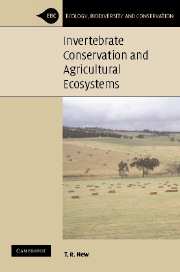Book contents
- Frontmatter
- Contents
- Preface
- Acknowledgements
- 1 Introduction: agricultural ecosystems and conservation
- 2 Agriculture and biodiversity: the place of invertebrates
- 3 Agriculture: effects on invertebrate diversity and conservation
- 4 Agricultural disturbance: diversity and effects on invertebrates
- 5 Biological control and invertebrate conservation
- 6 Cultural aspects of pest management
- 7 Extending beyond cropping areas
- 8 Field margins and landscape ecology
- 9 Pasture management and conservation
- 10 Towards more holistic management for invertebrates
- References
- Index
- Frontmatter
- Contents
- Preface
- Acknowledgements
- 1 Introduction: agricultural ecosystems and conservation
- 2 Agriculture and biodiversity: the place of invertebrates
- 3 Agriculture: effects on invertebrate diversity and conservation
- 4 Agricultural disturbance: diversity and effects on invertebrates
- 5 Biological control and invertebrate conservation
- 6 Cultural aspects of pest management
- 7 Extending beyond cropping areas
- 8 Field margins and landscape ecology
- 9 Pasture management and conservation
- 10 Towards more holistic management for invertebrates
- References
- Index
Summary
Increasing commitment of land to agriculture and the intensification of agricultural practices in many parts of the world have been associated with widespread and substantial loss of biodiversity, much of it undocumented and unheralded. As the most diverse larger components of that biodiversity, insects and other invertebrate animals play major roles in ecosystem function and sustainability in both natural and modified ecosystems, including agricultural ecosystems. However, agriculturists and conservationists have a long history of differing attitudes towards these animals. The former are concerned with crop and other commodity protection, in which depredations by invertebrate pests cause major economic losses, and suppression of their effects (commonly by killing them) is a major management necessity. The latter are concerned over the replacement of complex natural habitats with relatively simple ‘agroecosystems’, which reputedly support only very limited numbers of species, and with the wider environmental ramifications of crop-protection measures, such as use of pesticides and exotic species on non-target areas and species.
This book is both an introduction to the principles of agricultural pest management for invertebrate conservation biologists and an introduction to invertebrate importance and conservation for applied entomologists and pest managers. My major aim is for each party to appreciate more fully the perspectives of the other and to realise the amount of common ground that their viewpoints may encompass.
- Type
- Chapter
- Information
- Invertebrate Conservation and Agricultural Ecosystems , pp. xi - xiiPublisher: Cambridge University PressPrint publication year: 2005

